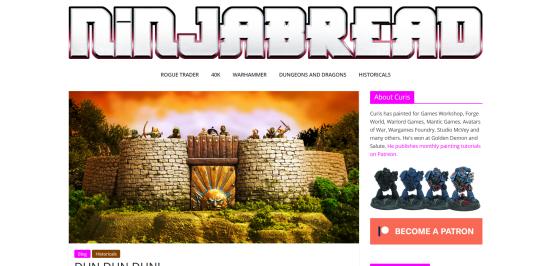Background:
The theme for this round of Last Painter Standing is Junkyard.
Of the six mechs that we received in the package, I chose the Hoplite. One of the reasons is that this is an older mech originally used during the Star League era of the Classic BattleTech (CBT) universe (approximately 300+ years earlier than the current CBT timeline of 3070), and would probably be found in some long-forgotten scrapheap on a backwater planet. The second reason is that this mini has a ton of great details and panel lines that I can use to display wear-and-tear weathering techniques (which I wanted to emphasize in this round).
This is an excerpt from the CBT Technical Read Out for the Hoplite, that sheds some light into its past history and why it doesn't have arms/hands (in case you were thinking that it is kind of a funny-looking mech):
A Star League design long thought lost, the Hoplite has reappeared in the ranks of Wolf's Dragoons. No one has yet discovered where the mercenaries got the BattleMech, but it seems likely that the Dragoons simply found some mothballed on a forgotten Periphery world... With no short-range weapons and arms nearly incapable of physical attacks, however, the Hoplite can be vulnerable up close, and is often paired with another 'Mech such as the Enforcer to help protect it.
Though being on an extreme scale with this mini and the first-round theme, my goal was to show folks how to do wear-and-tear weathering techniques while trying to convey a "lost in time" feel to the overall composition. Kind of like going to the junkyard and seeing that old car sitting there, thinking that you can get it up running again. Hopefully, I will be successful in doing this!
Mini Assembly:
The Hoplite was a relatively simple mini to put together, and came in only three parts – the body and right/left legs. The base is not provided in the packaging with the mini itself, but can be purchased separately in packs of 4. (Fortunately, Bill was kind enough to supply enough bases for every mini that he sent.) There was a little flash and a few mold pour-tabs that were taken care with a hobby knife and file.

Tip: One thing I've found useful in assembling minis - especially ones that have heavy or cumbersome limbs, weapons, etc. - is to use a small bit of greenstuff when gluing the piece on. Just break off a tiny piece and place it into the joint, socket, or grove, and add your glue. The greenstuff stuff helps in holding the pieces together while the glue dries, and adds strength to the bond. It can also be helpful in filling in gaps that can look unsightly after the pieces are together.
Base Prep:
I usually like to do all the basing prep before I prime the mini. I've seen others do the mini and base separate, but a good majority of CBT minis come with feet/base-plates that would require some serious hacking to get off - with a good possibility of damaging the mini itself. I glue the mini into the hexbase, and then fill in the gaps with drywall spackling. This is a great filler to use with modeling. It's cheap, non-toxic (you can work it with your fingers without having to wear gloves), dries quickly, and a tub of it will last a few hundred minis.

I wanted to keep the theme of Junkyard with the base work, also. Raiding the bits box, plus using the sprue that the legs were attached to in the package and an old watch, I found the right amount of parts for the Junkyard scene. I also took some Woodland Scenics medium ballast (red rock-looking pieces) to fill in areas where there is no junk present.
I took a hammer and smashed the watch, being careful with the lens (since this will cut you if you don't pay attention). This loosened up the gears and housing inside enough to pry it out. I also took a pair of pliers, and bent and snipped-out parts until I had a nice pile to pick through. I used the same pliers to cut and bend pieces of the sprue into odd shapes and angles, to simulate flat pieces of scrap.
After I got the parts and pieces together, I used super glue to glue them randomly on the base - taking care to place a few of the gears in a more upright position, to give a little more dynamic effect to the overall scene.

Prime and Initial Basecoat:
I wanted to prime the mini in white (GW Primer), since the basecoat and overall scheme would be a light color. I find that wear-and-tear weathering shows up much better on lighter colors (whites, light/medium greys, yellows, etc.) than darker colors. A couple of light coats are better than a single coat. I didn't worry about the base-work material getting completely covered, since the base will be painted a very dark grey with a heavy wash in the base-work step.

For the basecoat, I wanted to go with off-white or a dirty white color. So, I completely painted the mini with Reaper's White Leather. Probably one of the best paint colors to use as a basecoat when painting white. After letting the paint dry, I used a fairly heavy wash of GW Black Ink, Future, and water (ratio estimates – 50% ink, 25% Future, 25% water) applied over the entire mini. This might look sloppy at first, but the painting steps should take care of this, clean it up a bit, and look much better later.









